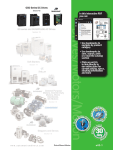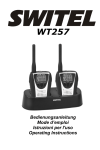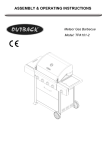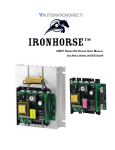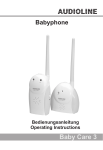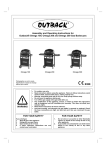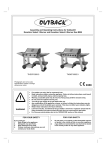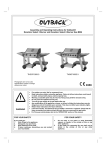Download ASSEMBLY & OPERATING INSTRUCTIONS
Transcript
ASSEMBLY & OPERATING INSTRUCTIONS OUTBACK COMMERCIAL Model: TPA101-6 Page Table of Contents 3 4 4 5 8 9 10 11 12 15 17 17 18 19 2 Chapter 1: Safety Information Chapter 2: Package Contents List Chapter 2: Hardware Contents List Chapter 3: Assembly Chapter 4: Leak Testing Chapter 5: Important Information Chapter 6: Gas, Regulator and Hose Chapter 7: Installation Chapter 8: Operation Chapter 9: Care and Maintenance Chapter 10: Technical Specifications Chapter 11: Troubleshooting Chapter 12: Parts Diagram Chapter 13: Parts List Safety Information WARNING • For outdoor use only. Not for commercial use. • Read instructions before using the appliance. Failure to follow instructions could result in death, serious bodily injury, and/or property loss. • Warning: accessible parts may be very hot. Keep young children and pets away. • Do not move the appliance during use. • Any modification of the appliance, misuse, or failure to follow the instructions may be dangerous and will invalidate your warranty. This does not affect your statutory rights. • For Flare-up control please refer to the ‘OPERATION’ section of this manual. Retain these instructions for future reference. • Turn off the gas supply at the gas bottle after use. • Leak test annually, and whenever the gas bottle is removed or replaced. • Check that the hose connections are tight and leak test each time you reconnect the gas bottle. FOR YOUR SAFETY • If you smell gas: • Shut off gas to the appliance. • Extinguish any open flame. • Open barbecue lid or hood. • If odour continues, discontinue use and contact your local dealer. FOR YOUR SAFETY • Do not store or use petrol or other flammable vapours or liquids in the vicinity of this or any other appliance. • A gas bottle not connected for use must not be stored in the vicinity of this or any other appliance. 3 Package Contents List A. Firebox --------1pc. B. Cart Assembly-----1pc. C. Cooking Griddle--1pc. D. Wheel Cap------2pcs E. Wheel----2pcs F. Wheel Axle- ------1pc. G. Side Shelf Support-----2pcs. H. Swivel Caster with Brake---1pc I. Swivel Caster---------1pc. J. Grease Cup Holder----- 2pcs. K. Grease Cup----------2pcs. L. Flame Tamer----------5pcs. M. Gas Grill Cooking Grid--3pcs N. Rubber Stopper--------2pcs Carefully unpack the packing box and remove all contents before commencing assembly. Make sure that you obtain all correct package contents. Hardware Contents List Item 4 Description Quantity AA 1/4-in. x 15-mm Round Head Screw 20 BB Allen Key 1 CC M12. Nut 2 DD 1/4-in. x 12-mm Round Head Screw 2 EE 1/4-in Flat washer 2 FF 1/4-in Lock washer 8 AA EE BB CC FF DD Assembly UNPACKING CAUTION: Obtain the aid of an assistant when handling large or heavy grill components. 7. Attach the wheel axle (F) through the cart legs, as shown below picture, then attach the two wheels (E) with two M12 nuts (CC), and attach two wheel caps (D) with two 1/4-in. x 12mm round head screws (DD) and two1/4-in flat washers (EE) at the end of the wheel axle (F). 1. Once the top of shipping box is open, obtain the aid of an assistant and lift the cardboard sleeve up over Firebox and components. 2. Use sleeve as a work surface to protect floor and grill parts from scratches. E 3. Remove all packing materials from around grill exterior. D 4. Open both Firebox lids and remove packing materials and components inside each Firebox chamber. CC F 5. Open the four latches as below. DD EE 8. Attach the swivel casters (I) and swivel caster with brake (H) using eight 1/4" x15 mm round head screws (AA) with 1/4-in lock washer (FF), four for each caster. Ensure the swivel caster with brake (H) is at the front of the cart frame. Tighten the eight screws. Latch 6. With the help of an assistant, lift the firebox (A) away from the cart assembly (B) separating the two pieces. Remark: the lighting stick is preassembled on the cart leg H FF AA I 5 Assembly 9. Attach the right side shelf support (G) with six 1/4‘’ x 15mm round head screws (AA), repeat the same step to attach left side shelf support. Ensure all screws are secured tightly. Make sure the side shelf buffers are pointing upward when attaching the side shelf support. 11. Open the latch between side shelf, left & right. AA G AA G 10. With the help of an assistant, align the grill body to the cart as shown below, then lock the four latches, securing the firebox to the cart. 6 12. Unfold side shelf, left & right and wind shield and place the tabs of the side wind shields into the small openings securing the windshield. Remark: The lighting stick is preassembled on the cart leg Assembly 13. Place the flame tamer (L) and gas grill cooking grids (M) in the firebox and secure them. Then place the cooking griddle (C) as shown below. 15. To install the battery ( not supplied), turn the ignition button cap counterclockwise and remove it. Insert the battery into the housing with the positive (+) terminal facing outward. Screw the ignition button cap back into place. M L C NOTE: Rubber stoppers are provided and should only be used for transportation of the unit. Place rubber stopper into the grease drainage hole when you have finished cooking and the grill has cooled. This will help to avoid grease dripping from the firebox during transport. 14. Put the grease cups (K) into grease cup holder (J). Then hang the grease cup holder on the bottom of the firebox, as shown below. J K WARNING Please remove the rubber stopper from the grease hole before using. 7 Assembly 13. Place the flame tamer (L) and gas grill cooking grids (M) in the firebox and secure them. Then place the cooking griddle (C) as shown below. 15. To install the battery ( not supplied), turn the ignition button cap counterclockwise and remove it. Insert the battery into the housing with the positive (+) terminal facing outward. Screw the ignition button cap back into place. M L C NOTE: Rubber stoppers are provided and should only be used for transportation of the unit. Place rubber stopper into the grease drainage hole when you have finished cooking and the grill has cooled. This will help to avoid grease dripping from the firebox during transport. 14. Put the grease cups (K) into grease cup holder (J). Then hang the grease cup holder on the bottom of the firebox, as shown below. J K WARNING Please remove the rubber stopper from the grease hole before using. 7 Important Information Please read these instructions carefully before assembly and use of your barbecue. • • • • • • • • • • • • • • • • • • • • • • • • • • Retain these instructions for future reference. This product is for outdoors use only. Do not use indoors. Remove plastic wrap from any part before lighting. Do not use within 1m of any flammable structure or surface. Do not use under any combustible surface. Open the barbecue lid before lighting. Once lit, do not move the barbecue until it has completely cooled, after use. This barbecue must not be left unattended when lit. The lid handle can become very hot. Grip only the centre of the handle. Always use oven gloves when cooking or carrying out any adjustments to the barbecue. Use purpose designed barbecue tools with long, heat resistant handles. Use caution when opening the lid, as hot steam inside is released upon opening. Parts of this barbecue become very hot – care must be taken, especially when children, elderly people, and animals are present. Never cover a barbecue until it has completely cooled. Use this barbecue only on a stable, flat surface. Do not store flammable materials near this barbecue. Do not use aerosols near this barbecue. Failure to follow the manual’s instructions could result in serious injury or damage. Modification of the barbecue may be dangerous, is not permitted and will nullify any warranty. regarding these instructions, contact your local dealer. Turn off the gas supply at the gas bottle after use. Do not use the barbecue or store gas bottles below ground level. LP gas is heavier than air so if a leak occurs the gas will collect at a low level and could ignite in the presence of a flame or spark. For use with LPG bottled gas only. A suitable regulator must be used for butane, propane or mixes. LP gas bottles should never be placed directly underneath the barbecue. LP gas bottles should never be stored or used laid on their side, in the horizontal position. A leak would be very serious and liquid could enter the gas line with serious result. Never store gas bottles indoors. Before you use your barbecue, perform a leak test. This is the only safe and sure way to detect any gas leaking from joints and connections of the barbecue after assembly. Leak test annually, and whenever the gas bottle is removed or replaced. 9 Gas, Regulator and Hose This barbecue can use either propane or butane or propane / butane mixed LPG (liquid petroleum gas) bottled gas. Propane bottles, will supply gas all year round, even on cold winter days. Butane bottles will supply sufficient gas in summer, but it may affect the performance of the barbecue and restrict the heat output available from the burners, particularly once the gas temperature starts to fall below +10°C. A spanner may be required to change gas bottles. Check that you have the correct gas bottle and regulator for your barbecue. Do not stand the bottle on the cart base. • The hose should hang freely with no bends, twisting, tension, folds, or kinks that could obstruct free flow of gas. Always inspect the hose for cuts, cracks, or excessive wear before use. • Apart from the connection point, no part of the hose should touch any hot barbecue parts. If the hose shows any sign of damage it must be replaced with a hose suitable for use with LP gas which meets the national standards for the country of use. • The length of hose should not exceed 1.5 metres. YOU MUST HAVE THE PROPER REGULATOR AND BOTTLE IN ORDER FOR THE BARBECUE TO OPERATE SAFELY AND EFFICIENTLY. USE OF AN INCORRECT OR FAULTY REGULATOR IS DANGEROUS AND WILL INVALIDATE ANY WARRANTY. Please consult your local gas dealer for the most suitable gas bottles and regulators. 10 Installation Selecting a Location This barbecue is for outdoor use only and should be placed in a well-ventilated area, and on a safe and even surface. Never place your barbecue below ground level. Take care to ensure that it is not placed UNDER any combustible surface. The sides of the barbecue should NEVER be closer than 1metre from any combustible surface, including trees and fences and make sure that there are no heat sources near the barbecue (cigarettes, open flames, spark etc.). Keep this barbecue away from any flammable materials! Precautions Do not obstruct any ventilation openings in the barbecue body. The lockable swivel caster should always have the brakes on when the barbecue is in use. Position the gas supply bottle on level ground next to the barbecue and safely away from any source of heat. Should you need to install or change the gas bottle, confirm that the barbecue is switched off, and that there are no sources of ignition (cigarettes, open flame, sparks, etc.) near before proceeding. Connecting a Gas Hose to the Barbecue Connect the gas hose to the gas rail inlet on the left hand side of the barbecue. Do not over tighten. Do not use any sealing tape, paste or liquid on the connection. Fixing a Regulator to the Gas Bottle Confirm all barbecue control knobs are in the off position. Connect the regulator to the gas bottle according to your regulator and bottle dealer’s instructions. 11 Operation Warnings •Before proceeding, make certain that you understand the IMPORTANT INFORMATION section of this manual . •Your barbecue is not designed to be used with more than 50% of the cooking area as a solid plate — this includes baking dishes. Full coverage will cause excessive build-up of heat and damage the barbecue. This is not covered by warranty. Preparation Before Cooking To prevent foods from sticking to the cooking surface, please use a long handled brush to apply a light coat of cooking or vegetable oil before each barbecuing session. (Note: When cooking for the first time, paint colours may change slightly as a result. This is normal and should be expected.) During use, the protective coating may come off the cooking surface. This is normal and is not harmful. Lighting the Barbecue • Open the barbecue hood or lid before lighting. Never light your barbecue with the hood or lid closed. • Ensure all knobs are in the off position. Open the gas control valve on the gas bottle or regulator. • Push and turn the second or fourth control knob to the high position. Push in and hold the igniter button for 4 to 5 seconds to light the burner. • If burner fails to ignite after following above procedure, turn all the knobs to the off position. Close the gas valve on the gas bottle. Wait 5 minutes. Reattempt all of the above steps. If the barbecue still fails to light, please refer to the manual ignition instructions below. • After successful lighting of the second or fourth burner, push and turn any control knob of the remaining burners to high in any order as needed. • After ignition, turn the burners to the high position for 3-5 minutes in order to pre-heat the barbecue. This should be done before each cooking session. The hood or lid should be open during preheating. • After completion of preheating, turn all burners to the low position for best cooking results. Manual Ignition Instructions •Open the barbecue lid before lighting. Never light your barbecue with the lid closed. •Ensure all knobs are in the off position. Open the gas control valve on the gas bottle or regulator. •Insert lit match through the left match-lighting hole on the leftside of the barbecue body and place near leftmost burner porthole. •Push and turn the leftmost control knob anti-clockwise to the high position, taking care to protect yourself from the flames. •When the left burner is lit, turn the remaining burners on from right to left. •Confirm that each burner is alight before turning on the next burner. •If a burner fails to ignite, contact your local dealer for assistance. •After ignition, turn the burners to the high position for 3-5 minutes in order to pre-heat the barbecue. This should be done before each cooking session. The hood or lid should be open during preheating. •After completion of preheating, turn all burners to the low position for best cooking results. 12 Operation Grids Cooking The food on the grid is cooked by the heat produced from the flame tamer below. The natural food juices produced during cooking fall onto the flame tamer below and vaporise The subsequent rising smoke bastes the food, as it travels upwards, imparting that unique barbecued flavour. Roasting Lid Cooking Barbecues equipped with a roasting lid give the option to form an ‘oven’ for roasting or baking food, such as joints of meat or whole chickens, etc. More even cooking of food will actually be achieved by using the barbecue with the lid down. For best results, place the food you wish to bake or roast on a metal baking tray and set it on one side of the cooking grill. Close the lid to cook the food ‘indirectly’. Avoid lifting the lid unnecessarily as heat is lost every time the hood is opened. If the lid is opened during cooking, please allow extra time for the barbecue to regain its temperature and complete the cooking. Use the temperature gauge to monitor the heat of the barbecue. Turn the burner directly under the food to the OFF position and turn all other burners to a LOW to MEDIUM position. If the internal heat becomes too high, turn the burners down to the low position. It is not necessary or advisable to have all of the burners on high when the lid is closed. Flare-Up Control Flare-ups occur when meat is barbecued, and its fat and juices fall upon the flame tamer. Smoke of course helps give food its barbecued flavour, but it is best to avoid excessive flare-up to prevent food being burned. To control flare-ups, it is ABSOLUTELY ESSENTIAL to trim away excess fat from meat and poultry before grilling, use cooking sauces and marinades sparingly and try to avoid very cheap cuts of meat or meat products as these tend to have a high fat and water content. Also, the burners should always be placed on the low setting during cooking. When flare-ups do occur, they can usually be extinguished by applying baking soda or salt directly onto the flame tamer. Always protect your hands when handling anything near the cooking surface of the barbecue and take care to protect yourself from the flames. If a fat fire occurs, please see the instructions given below. 13 Operation Fat Fires Empty and clean the grease tray (and grease cup) of food debris after each cooking session. If the barbecue is to be used for large gatherings, it will be necessary to turn off and cool the barbecue every two hours to remove food debris from the grease tray (and grease cup) and clean it out. The time between cleaning may need to be reduced if very fatty foods or cheap meat products are being cooked. Failure to do this may result in a fat fire, which may cause injury and could seriously damage the barbecue. In the event of a fat fire: •If safe to do so, turn all control knobs to the ‘off’ position. •Turn off the gas supply at the gas bottle. •Keep everyone at a safe distance from the barbecue and wait until the fire has burnt out. •Do not close the lid of the barbecue. •NEVER DOUSE A BARBECUE WITH WATER. IF AN EXTINGUISHER IS USED, IT SHOULD BE A POWDER TYPE. •DO NOT REMOVE THE DRIP TRAY. •If the fire does not seem to be abating or appears to be worsening, contact your local Fire Brigade for assistance. End of Cooking Session After each cooking session, turn the barbecue burners to the “high” position and burn for 5 minutes. This procedure will burn off cooking residue, thus making cleaning easier. Make sure the lid is open during this process. Turning Off Your Barbecue When you have finished using your barbecue, turn all the control valves fully clockwise to the “Off” position, then switch off the gas supply at the bottle. Wait until the barbecue is sufficiently cool before closing its lid. 14 Care and Maintenance Regularly clean your barbecue between uses and especially after extended periods of storage. Ensure the barbecue and its components are sufficiently cool before cleaning. Do not leave the barbecue exposed to outside weather conditions or stored in damp, moist areas. • • Never handle hot parts with unprotected hands. Never douse the barbecue with water when its surfaces are hot. In order to extend the life and maintain the condition of your barbecue, we strongly recommend that the unit be covered when left outside for any length of time, especially during the winter months. Heavy-duty Outback® barbecue covers and other accessories are available from your local Outback® stockist. Even when your barbecue is covered for its protection, it must be inspected on a regular basis as damp or condensation can form which may result in damage to the barbecue. It may be necessary to dry the barbecue and the inside of the cover. It is possible for mould to grow on any fat remaining on parts of the barbecue. This should be cleaned off smooth surfaces with hot soapy water. Any rust that is found that does not come into contact with the food should be treated with a rust inhibitor and painted with barbecue paint or a heat resistant paint. A chrome cleaner may be used on chrome parts if required. To prevent rusting with cooking oil after rinsing and drying. Cooking Surfaces When the barbecue has cooled, clean with hot soapy water. To remove any food residue, use a mild cream cleaner on a non-abrasive pad. Do not use scouring pads or powders as they can permanently damage the finish. Rinse well and dry thoroughly. Due to the weight of the cooking surfaces, we do not recommend cleaning in a dishwasher. It is quite normal for surface rust to be present on the cooking surface. If rust appears between uses or in storage, clean with a soft brass wire brush. Be careful not to damage the cooking surface, re-oil and cure. Barbecue Lid Use a non-abrasive cloth or pad and clean with hot, soapy water. Do not use scouring pads or powders as they can permanently damage the finish. Flame Tamer Remove any food residue from the flame tamer surface with a plastic or wooden scraper or brass wire brush. Do not use a steel scraper or wire brush. Clean with hot soapy water and rinse well. Barbecue Body Regularly remove excess grease or fat from the barbecue body using a cloth wrung out in hot soapy water and dry thoroughly. Excess fat and food debris can be removed from inside the body using a soft plastic or wooden scraper. It is not necessary to remove all the grease from the body. If you need to clean fully, use hot soapy water and a cloth, or nylon-bristled brush only. Do not use abrasives. Remove cooking surfaces and burners before full cleaning. Do not immerse the gas controls or manifold in water. Check burner operation after carefully refitting into body. 15 Care and Maintenance Burner Provided that they are operating correctly, in normal usage, burning off the residue after cooking will keep the burners clean. The burners should be removed and cleaned annually, or whenever heavy build-up is found, to ensure that there are no signs of blockage (debris, insects) in either the burner portholes or the primary air inlet of the burners. Use a pipe cleaner to clear obstructions. When re fitting the burners, be careful to check that the neck of the burner fits over the valve outlet . It is quite normal for surface rust to be present on the burners. If rust appears between Grease Cup After every use, empty and clean the grease cup of any fat or food particles, using a plastic or wooden scraper if necessary. Failure to keep it clean, and excessive build up can result in a fat fire. This can be hazardous and severely damage the barbecue. This is not a fault in the barbecue and is therefore not covered by the terms of the warranty. If required, the cup can be washed in hot soapy water. Fixings All screws and bolts, etc. should be checked and tightened on a regular basis. Storage Ensure the barbecue is properly cooled before covering or storing. Store your barbecue in a cool dry place. Cover the burners with aluminum foil in order to prevent insects or other debris from collecting in burner holes. 16 If the barbecue is to be stored indoors, the gas bottle must be disconnected and left outside. The gas bottle should always be stored outside, in a dry, well-ventilated area, The gas bottle should always be stored outside, in a dry, well-ventilated area, away from any sources of heat or ignition. Do not let children tamper with the bottle. When using the barbecue after extended periods of storage follow the cleaning procedures. Technical Specifications Name Commercial CE Approval CE0359 359CL114 Heat Input Burners 20.51kW 5 injector Gas/Pressure 1.02mm Butane:28-30 mbar Propane: 37 mbar 1.02mm LPG mixture:30 mbar 0.99mm LPG mixture:37 mbar 0.91mm LPG mixture:50 mbar Gas Consumption: Main burner: 1497g/h Countries of Use: I3+ (28-30/37) BE, CH, CY, CZ, ES, FR, GB, GR, IE, IT, LT, LU, LV, PT, SK, SI I3B/P(30) BE, CY, DK, EE, FI, FR, HU, IT, LT, NL, NO, SE, SI, SK, RO, HR, TR, BG, IS LU, MT,CZ I3B/P(50) AT, CH, DE, SK I3B/P(37) PL Troubleshooting BEFORE CALLING FOR SERVICE If the grill does not function properly, use the following checklist before calling for service. You should inspect the burners at least once a year or immediately after any of the following conditions occur: PROBLEMS Grill won’t light when the control knob is rotated. Burner flame is yellow or orange, in combination with the odor of gas. Low heat with knob in “HI” position. WHAT TO DO Check to see if LP tank is empty. Clean wires and/or electrode by rubbing with alcohol and clean swab. Wipe with dry cloth. Make sure the wire is connected to electrode assembly. Do other burners on the unit operate? Check to see if other burners operate. If so, check the gas orifice on the malfunctioning burner for an obstruction. Refer to Clean Burner Tubes and Burner Ports on page 16. Is the fuel hose bent or kinked? Is the grill in a dusty area? Is there adequate gas supply available? If it is only one burner that appears low, does the orifice or burner need cleaning? Is the gas supply or gas pressure low? 17 Parts Diagram 18 Important: Keep this Instruction Manual for future reference and part replacement. To make sure you obtain the correct replacement parts for your gas grill, please refer to the parts list on next page. Parts List Part # Description Quantit y Part # Description Quantity 1 Side Shelf, Left 1 22 Firebox Support, Right 1 2 Side Shelf Handle 2 23 Rubber Stopper 2 3 Side Shelf Buffer 4 24 Grease Cup Holder 2 4 Side Shelf Support 2 25 Grease Cup 2 5 Wind Shield 1 26 Main Manifold 1 6 Gas Grill Cooking Grid 3 27 LP Regulator 1 7 Flame Tamer 5 28 Cart Leg, Left 1 8 Main Burner 5 29 Cart Leg Insert 8 9 Main Burner Ignitor A 1 30 Cart Base 1 10 Main Burner Ignitor B 1 31 Screw 4 11 Main Burner Bowl Assembly 1 32 Cart Leg Support A 2 12 Firebox Support, Left 1 33 Swivel Caster 1 13 Lighting Stick 1 34 Swivel Caster with Brake 1 14 Front Baffle 1 35 Glide Bar 2 15 Main Burner Gas Valve 5 36 Cart Leg Support B 2 16 Pulse Igniter Module 1 37 Cart Leg, Right 1 17 Main Control Panel 1 38 Wheel 2 18 Bezel 5 39 Wheel Axle 1 19 Control Knob 5 40 Wheel Cap 2 20 Flame Lighting Tube 1 41 Cooking Griddle 1 21 Side Shelf, Right 1 19




















